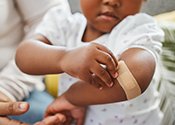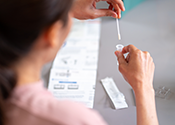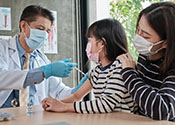
This Yale School of Medicine fact sheet provides answers to commonly asked questions about the newly authorized Pfizer and Moderna COVID-19 vaccines for children under 5 years old. Data is included on safety, efficacy, dosage, timing, and where and how to access the vaccines.
- News

Bivalent COVID-19 boosters for children ages 5 and older, offering protection against the Omicron variant of the virus, have now been approved by both the FDA and the CDC. These boosters are available for any child in this age range who has already received their initial two-vaccine series.
- News

This Kaiser Family Foundation brief explains the public health implications of the Biden Administration’s plan to end national COVID-19 public health emergency declarations on May 11, 2023. For example, at-home COVID tests will no longer be free through the federal government but instead will be billed through insurance.
- News

This Q&A with physician and public health expert Dr. Leana Wen describes the implications of the “tripledemic” of COVID alongside respiratory syncytial virus (RSV) and influenza, particularly in pediatric populations. The article explains that many pediatric hospitals are strained from the combination of cases they are treating and discusses common-sense preventative measures like good ventilation, hand hygiene, masking, and testing.
- News

Age requirements for COVID-19 vaccines vary among large pharmacy chains, with many offering vaccines only for children ages 3 and older. This article describes policies for some of the major U.S. pharmacy chains and contains a link from a volunteer group called Vaccinate Under Five working to create a national pharmacy and provider database.
- News

Responding to data revealing that the pandemic accelerated a decline in students’ mental health, this article describes how numerous states are combining COVID relief dollars with local funding to support youth mental health. Specific efforts include programs to help identify and support students who may be struggling and initiatives to foster emotional well-being and school–community connectedness.
- News

According to CNN, the COVID-19 vaccine—including boosters for eligible individuals—has been added to the CDC’s schedule of routine vaccines for both pediatric and adult populations. Public health officials hope that this update will “normalize” the vaccine and encourage the general public to stay up to date, as they would with any other routine vaccine.
- News

This article describes the research validating the safety of pediatric COVID vaccines and their efficacy at preventing serious illness and death. It explores why some parents are still hesitant to vaccinate their children and provides some rationales for children to receive COVID vaccines.
- News

This article details the FDA approval of a booster shot targeting COVID subvariants that have recently been dominant in the United States. Boosters are expected to be available in early September for adults and for children 12 and older.
- News

Households can now order up to four free at-home rapid antigen COVID tests through a partnership between the U.S. Department of Health and Human Services and the U.S. Postal Service that has been renewed for winter 2022–23. The COVID.gov testing website also contains information on how to access at-home tests at retailers and pharmacies and how to obtain insurance reimbursement for those tests.
- News

This blog post explains how California’s recent investment in student mental and behavioral health services—the $4.7 billion Master Plan for Kids’ Mental Health, which is targeted at interventions like increasing the number of school counselors—will be instrumental in addressing increases in student mental health symptoms brought on by the pandemic.
- News

This article explains how anxiety and depression among adolescents “have surged amid the isolation, disruption, and hardship of COVID-19.” Over a third of districts nationally are spending federal COVID relief dollars on mental health professionals, and just under a third are funding social-emotional learning efforts, but experts say far more support is needed.
- News

This article describes the growing chronic absenteeism in U.S. public schools, which has doubled from pre-pandemic numbers. District strategies to improve attendance among chronically absent students—those missing 10% or more of school days—include regularly collecting and sharing data, conducting home visits, and making additional efforts to foster a sense of belonging at school.
- News

This Scientific American article describes the causes and implications of extremely low vaccine uptake in the United States for young children, particularly those under 5 years old. The article also discusses potential solutions, focusing on the role of the pediatrician as a trusted resource.
- News